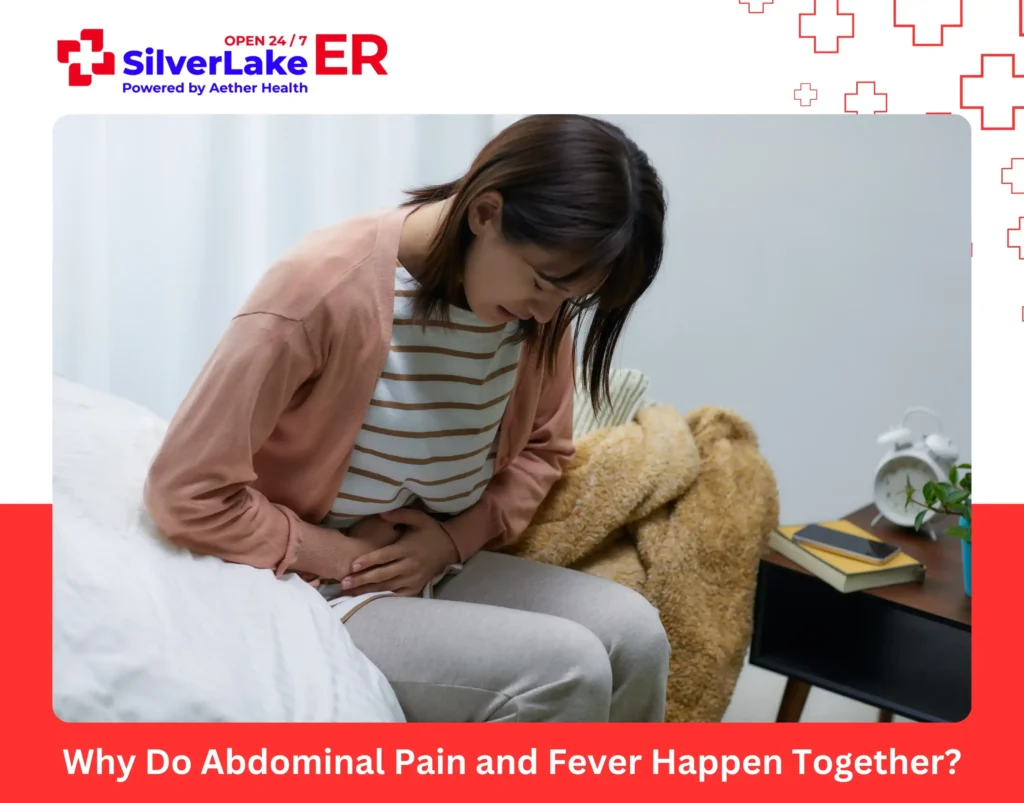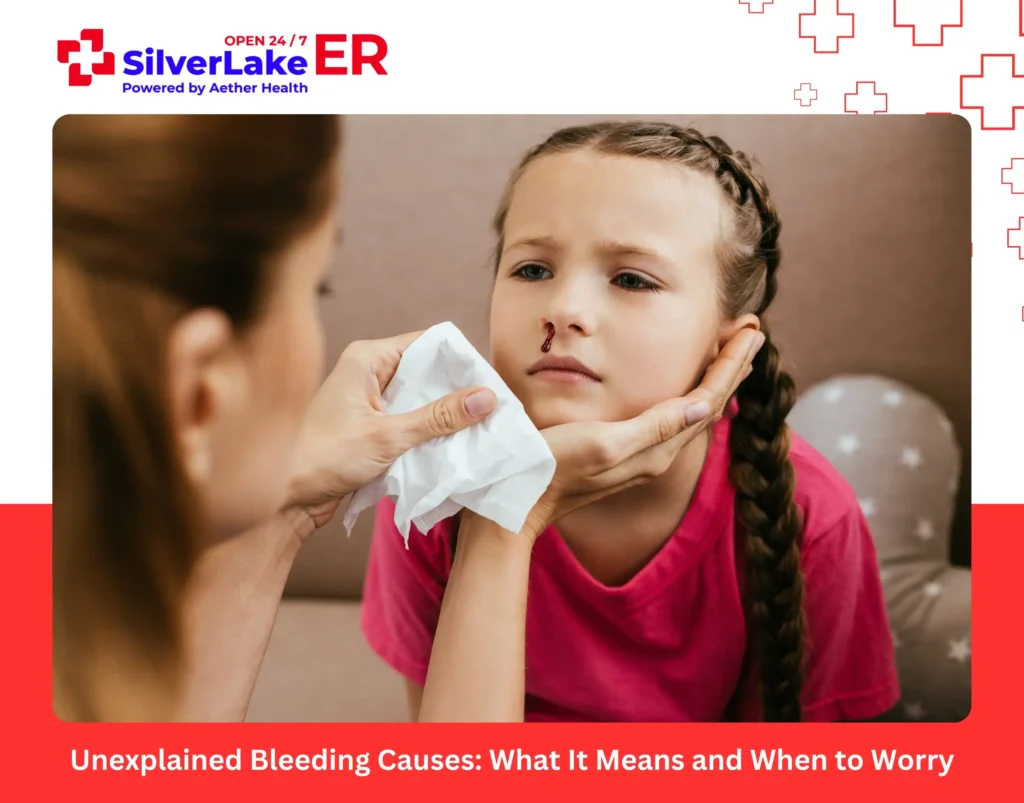The abdomen holds vital organs: liver, appendix, kidneys, and intestines, and when pain comes with fever, it’s a sign that one of them might be in trouble. Appendicitis, gallbladder infection, or kidney infection can all start with mild abdominal pain and a low-grade fever but progress to sepsis or organ rupture within hours.
The danger lies in delay: early infection can be treated with antibiotics; late infection can require surgery or intensive care. That’s why it’s important to know what could be causing your symptoms, so you can act before the condition turns life-threatening.
This guide will help you understand what might be causing your symptoms and when to head to the ER. Every hour matters when an infection spreads or an organ is at risk.
Why Do Abdominal Pain and Fever Happen Together?

When you have both abdominal pain and fever, it usually means:
- Your body is fighting an infection.
- Something is inflamed inside your abdomen.
- Your immune system is responding to a problem.
Think of fever as your body’s alarm system. It’s raising your temperature to fight what is causing the pain. Abdominal pain with fever always deserves immediate medical attention.
7 Common Causes of Abdominal Pain With Fever
Here are some common reasons, from mild to complex, why you might have abdominal pain with fever.
1. Appendicitis (Inflamed Appendix)
Appendicitis happens when the appendix becomes inflamed or infected. Pain often starts near your belly button, then moves to the lower right side of your abdomen. It gets worse over several hours.
Other symptoms:
- Fever (usually 99-102°F)
- Loss of appetite
- Nausea and vomiting
- Can’t pass gas
Why it’s serious: Your appendix can rupture within 24-72 hours, causing a life-threatening infection called peritonitis.
2. Gastroenteritis (Stomach Flu)
It’s usually viral and causes cramping all over your stomach that comes and goes.
Other symptoms:
- Low-grade fever
- Diarrhea (watery or bloody)
- Vomiting
- Feeling weak
Why it matters: Severe dehydration can be dangerous, especially for children and seniors.
3. Diverticulitis (Infected Colon Pouches)
This condition happens when small pouches in your colon become inflamed or infected. It usually causes persistent pain in the lower left side of your abdomen (sometimes on the right).
Other symptoms:
- Fever and chills
- Constipation or diarrhea
- Nausea
- Bloating
Why it’s serious: It can lead to abscesses or a hole in your colon.
4. Gallbladder Infection (Cholecystitis)
Sudden, intense pain in the upper right side of your abdomen, often after eating fatty foods. Pain may spread to your right shoulder.
Other symptoms:
- Fever above 100°F
- Nausea and vomiting
- Yellowing of skin or eyes (jaundice)
- Pain lasting more than 6 hours
Why it’s serious: Your gallbladder can rupture or cause a widespread infection.
5. Kidney Infection (Pyelonephritis)
Pain in your side, back, or groin. It may feel like intense abdominal pain.
Other symptoms:
- High fever and chills
- Burning during urination
- Urgent need to urinate
- Cloudy or bloody urine
Why it’s serious: Kidney infections can spread to your bloodstream (sepsis).
6. Pelvic Inflammatory Disease (PID)
For women, lower abdominal pain with fever could be a sign of an infection in the reproductive organs, often due to untreated sexually transmitted infections (STIs). You may feel dull or sharp pain in your lower abdomen or pelvis.
Other symptoms:
- Fever
- Abnormal vaginal discharge
- Pain during sex
- Irregular periods
Why it’s serious: It can cause permanent damage to reproductive organs and infertility.
7. Pancreatitis (Inflamed Pancreas)
This may cause severe upper abdominal pain that radiates to the back.
Other symptoms:
- Fever
- Rapid pulse
- Nausea and vomiting
- Tender, swollen abdomen
- Pain worsens after eating.
Why it’s serious: Can be life-threatening without immediate treatment.
The cause often depends on where the pain is located. Abdominal Pain Chart: What Each Area Tells You can help you identify it easily.
When Should You Go to the Emergency Room?

Mild stomach pain can go away sometimes with rest, hydration, or over-the-counter remedies. But certain red flags indicate you should seek immediate medical attention at Silverlake ER:
- Severe, persistent pain that doesn’t improve or worsens
- High fever above 103°F (39.4°C) or fever lasting more than three days
- Persistent vomiting
- Signs of dehydration: decreased urination, extreme thirst, dizziness, or confusion
- Bloody or black stools (potential gastrointestinal bleeding)
- Abdominal rigidity or severe tenderness when touching the abdomen
- Vomiting blood
- Jaundice (yellowing of skin or eyes)
- Chest pain accompanying abdominal symptoms
- Pregnancy with any combination of abdominal pain and fever
- Difficulty breathing or rapid heartbeat
- Recent abdominal surgery followed by pain and fever
Remember: Even if your symptoms seem mild, don’t second-guess your instincts. If something feels wrong, it’s better to get checked out.
What Happens at Silverlake ER?

When you arrive with abdominal pain and fever, here’s what to expect:
Step 1: Quick Triage
We’ll assess your symptoms immediately and prioritize based on severity. Life-threatening conditions are treated first.
Step 2: Medical Evaluation
Our emergency physicians will:
- Ask about your symptoms and medical history.
- Perform a thorough physical examination.
- Check exactly where your pain is located.
- Test for tenderness and swelling
Step 3: Diagnostic Tests
Depending on your symptoms, we may perform:
- Lab tests to check for infection, inflammation, and organ function
- Urinalysis to rule out kidney or bladder infections
- Ultrasound to view your gallbladder, appendix, or reproductive organs
- CT scan for detailed images of your abdomen
- X-rays to check for blockages or perforations
- Pregnancy test for women of childbearing age
Step 4: Treatment
Your treatment plan may include:
- IV fluids to rehydrate and restore electrolytes
- Antibiotics for bacterial infections
- Pain medication to make you comfortable
- Anti-nausea medication to stop vomiting
- Hospital admission for conditions requiring ongoing care
Home Care While Monitoring Symptoms
If your symptoms are mild and you’re monitoring the situation, try these remedies:
- Rest and avoid strenuous activity.
- Stay hydrated with water, clear broths, or electrolyte drinks.
- Eat bland foods like crackers, toast, or rice (if you can tolerate food).
- Avoid caffeine, alcohol, and spicy or fatty foods.
- Apply heat (a heating pad on low) to your abdomen for cramping.
- Take your temperature regularly to monitor fever.
Important: These are temporary measures only. If symptoms worsen or don’t improve within 24 hours, come to the ER.
Final Thoughts
When abdominal pain and fever appear together, skip the home remedies and get urgent medical evaluation. On-site imaging, labs, and swift intervention at Silverlake ER are what prevent irreversible damage to your vital organs.
Our dedicated team of emergency professionals is available 24/7 to assess your symptoms, run on-the-spot tests, and start treatment without long waits.
Whether it’s appendicitis, gallbladder infection, or a stomach bug, we give you fast, compassionate care so you can get relief right away. The faster you get treatment, the safer the outcome.
FAQs
1. Can viral fever cause abdominal pain?
Viral infections, especially those affecting the gastrointestinal tract, can cause abdominal pain along with fever, nausea, and diarrhea.
2. What is a red flag for abdominal pain?
Severe, persistent pain, high fever, vomiting blood, or black stools need urgent care.
3. What to do if you have a fever and stomach pain?
Rest, stay hydrated, and eat bland foods. Seek medical help if symptoms worsen or last over 24 hours.
4. When to worry about abdominal pain in a child?
If your child has strong pain, high fever, vomiting, or swelling, seek immediate medical attention.
5. How to check for appendicitis in a child at home?
Pain in the lower right abdomen that worsens when pressing or releasing the area can suggest appendicitis; go to the ER right away.




